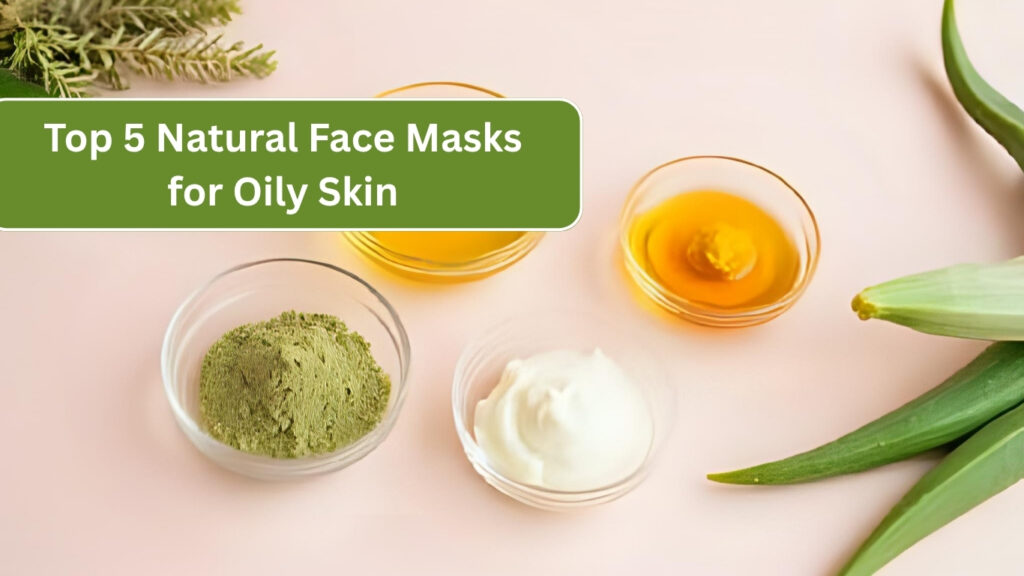When excess oil is the culprit behind shiny foreheads and stubborn breakouts, natural face masks can be a game-changer. Gentle yet effective, these DIY remedies leverage kitchen-cabinet ingredients to absorb sebum, unclog pores, and soothe inflammation without stripping your skin. Here are the top five natural masks to help oily skin stay balanced, healthy, and breakout-free.
1. Green Tea & Clay Mask
Key Benefits: Antioxidant boost + oil absorption
- Ingredients:
- 1 tablespoon green clay (or bentonite)
- 1 teaspoon matcha green tea powder
- Enough brewed green tea to form a paste
- Why it works:
- Clay draws out sebum and impurities.
- Green tea reduces inflammation and delivers polyphenols that regulate sebum.
- How to use:
- Mix clay and matcha.
- Gradually add green tea until spreadable.
- Apply for 10–12 minutes; rinse with lukewarm water.
- Frequency: 1× weekly.
2. Honey & Oatmeal Mask
Key Benefits: Gentle exfoliation + antibacterial action
- Ingredients:
- 1 tablespoon finely ground oats
- 1 tablespoon raw honey
- Optional: a few drops of tea tree oil
- Why it works:
- Oats exfoliate dead cells without irritation.
- Honey is naturally antibacterial and humectant, balancing hydration.
- Tea tree oil fights acne bacteria.
- How to use:
- Combine oats and honey (plus tea tree oil if using).
- Massage onto damp skin in circular motions for 1–2 minutes.
- Leave on 8–10 minutes; rinse thoroughly.
- Frequency: 1–2× weekly.
3. Yogurt & Turmeric Mask
Key Benefits: Brightening + oil-control
- Ingredients:
- 1 tablespoon plain Greek yogurt
- ½ teaspoon turmeric powder
- Why it works:
- Yogurt contains lactic acid for gentle exfoliation and probiotics for barrier support.
- Turmeric is anti-inflammatory and helps control sebum.
- How to use:
- Stir yogurt and turmeric into a smooth paste.
- Apply a thin layer; leave on 8–10 minutes (avoid staining clothes!).
- Rinse with lukewarm water and follow up with toner.
- Frequency: 1× weekly.
4. Apple Cider Vinegar (ACV) Toner-Mask Combo
Key Benefits: pH balance + pore tightening
- Ingredients:
- 1 part raw, unfiltered ACV
- 3 parts distilled water
- Why it works:
- ACV’s mild acids clarify pores and restore pH.
- Tannins in ACV act as a natural astringent.
- How to use as a mask:
- Mix ACV and water in a glass container.
- Soak a cotton pad and press gently on oily areas for 2–3 minutes.
- Rinse off if leaving longer than 5 minutes.
- Frequency: 2–3× per week as toner; mask once per week for 5 minutes.
Caution: Always patch-test ACV at 1:10 dilution first to prevent irritation.
5. Aloe Vera & Lemon Mask
Key Benefits: Soothing + sebum regulation
- Ingredients:
- 1 tablespoon pure aloe vera gel
- ½ teaspoon fresh lemon juice
- Why it works:
- Aloe vera calms redness and hydrates without oil.
- Lemon juice contains citric acid to exfoliate and control shine.
- How to use:
- Mix aloe gel and lemon juice.
- Apply evenly; leave on 10 minutes.
- Rinse thoroughly and apply moisturizer immediately.
- Frequency: 1× weekly (limit lemon use to avoid sensitivity).
Tips for Mask Success
- Clean skin first: Always apply masks to freshly cleansed skin.
- Follow with toner/moisturizer: Restore pH and seal in hydration.
- Don’t overdo it: Too-frequent masking can irritate and trigger oil rebound.
- Customize: Feel free to swap ingredients based on availability and sensitivity.
FAQs
Q1: Can I mix more than two ingredients?
Yes—but keep total ratios balanced (e.g., 2 parts base, 1 part active) to avoid over-exfoliation.
Q2: Will these masks prevent acne entirely?
They help manage oil and inflammation, but persistent acne may require targeted spot treatments or dermatologist advice.
Q3: How do I store leftover mask mixtures?
Most DIY masks are best fresh. If needed, store up to 2 days in a sealed container in the fridge.
Q4: Can I use these masks daily?
No—limit to 1–2× weekly based on mask strength and your skin’s tolerance.
Q5: Are essential oils safe in masks?
Use sparingly (1–2 drops) and patch-test first; some oils (e.g., tea tree) are beneficial, but others can irritate.






